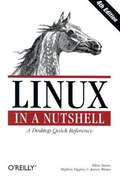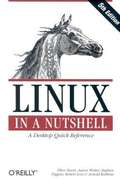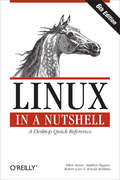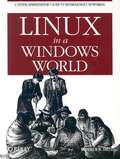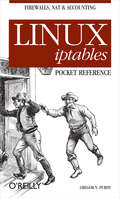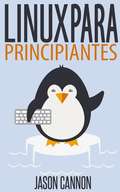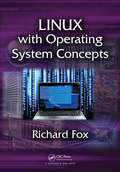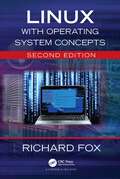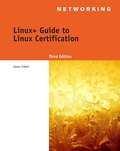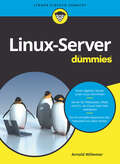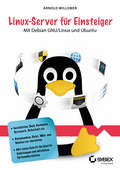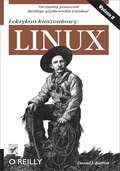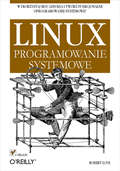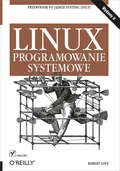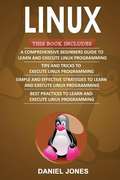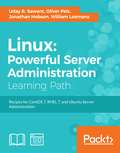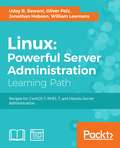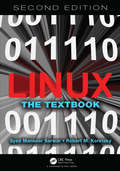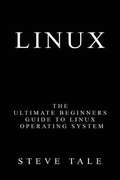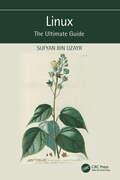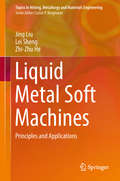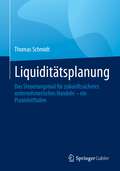- Table View
- List View
Linux in a Nutshell, 3rd Edition
by Stephen Figgins Jessica P. Hekman Ellen Siever Stephen SpainhourThis complete reference covers all user, programming, administration, and networking commands, with options, for common Linux distributions. It also documents a wide range of GNU tools. New material in the third edition includes common configuration tasks for the GNOME and KDE desktops and the fvwm2 window manager, the dpkg Debian package manager, expanded coverage of the rpm Red Hat package manager, and many new commands.
Linux in a Nutshell, 4th Edition
by Stephen Figgins Ellen Siever Aaron WeberComprehensive but concise, Linux in a Nutshell is an essential desktop reference for the commands that users of Linux utilize every day. It covers all substantial user, programming, administration, and networking commands for the most common Linux distributions. It's several quick references rolled into one: sed, gawk, RCS, CVS, vi, Emacs, bash, tcsh, regular expressions, package management, bootloaders, and desktop environments are all covered in this clear, to-the-point volume, along with core command-lin
Linux in a Nutshell, 5th Edition
by Arnold Robbins Stephen Figgins Ellen Siever Aaron Weber Robert LoveOver the last few years, Linux has grown both as an operating system and a tool for personal and business use. Simultaneously becoming more user friendly and more powerful as a back-end system, Linux has achieved new plateaus: the newer filesystems have solidified, new commands and tools have appeared and become standard, and the desktop--including new desktop environments--have proved to be viable, stable, and readily accessible to even those who don't consider themselves computer gurus. Whether you're using Linux for personal software projects, for a small office or home office (often termed the SOHO environment), to provide services to a small group of colleagues, or to administer a site responsible for millions of email and web connections each day, you need quick access to information on a wide range of tools. This book covers all aspects of administering and making effective use of Linux systems. Among its topics are booting, package management, and revision control. But foremost in Linux in a Nutshell are the utilities and commands that make Linux one of the most powerful and flexible systems available. Now in its fifth edition, Linux in a Nutshell brings users up-to-date with the current state of Linux. Considered by many to be the most complete and authoritative command reference for Linux available, the book covers all substantial user, programming, administration, and networking commands for the most common Linux distributions. Comprehensive but concise, the fifth edition has been updated to cover new features of major Linux distributions. Configuration information for the rapidly growing commercial network services and community update services is one of the subjects covered for the first time. But that's just the beginning. The book covers editors, shells, and LILO and GRUB boot options. There's also coverage of Apache, Samba, Postfix, sendmail, CVS, Subversion, Emacs, vi, sed, gawk, and much more. Everything that system administrators, developers, and power users need to know about Linux is referenced here, and they will turn to this book again and again.
Linux in a Nutshell: A Desktop Quick Reference (Nutshell)
by Arnold Robbins Stephen Figgins Ellen Siever Robert LoveEverything you need to know about Linux is in this book. Written by Stephen Figgins, Ellen Siever, Robert Love, and Arnold Robbins -- people with years of active participation in the Linux community -- Linux in a Nutshell, Sixth Edition, thoroughly covers programming tools, system and network administration tools, the shell, editors, and LILO and GRUB boot loaders. This updated edition offers a tighter focus on Linux system essentials, as well as more coverage of new capabilities such as virtualization, wireless network management, and revision control with git. It also highlights the most important options for using the vast number of Linux commands. You'll find many helpful new tips and techniques in this reference, whether you're new to this operating system or have been using it for years. Get the Linux commands for system administration and network managementUse hundreds of the most important shell commands available on LinuxUnderstand the Bash shell command-line interpreterSearch and process text with regular expressionsManage your servers via virtualization with Xen and VMwareUse the Emacs text editor and development environment, as well as the vi, ex, and vim text-manipulation toolsProcess text files with the sed editor and the gawk programming languageManage source code with Subversion and git
Linux in a Windows World
by Roderick W. SmithThe latest in O'Reilly's line of bestselling Linux titles, Linux in a Windows World is an invaluable companion for any system administrator interested in integrating Linux into their Windows environment. This book takes an in-depth look at exactly how Linux can be brought into an organization that's currently based on Microsoft Windows systems. Featuring a litany of insider tips and techniques, Linux in a Windows World dispenses all the practical advice you need to migrate to this revolutionary open source software.
Linux iptables Pocket Reference: Firewalls, NAT & Accounting
by Gregor N. PurdyFirewalls, Network Address Translation (NAT), network logging and accounting are all provided by Linux's Netfilter system, also known by the name of the command used to administer it, iptables. The iptables interface is the most sophisticated ever offered onLinux and makes Linux an extremely flexible system for any kind of network filtering you might do. Large sets of filtering rules can be grouped in ways that makes it easy to test them and turn them on and off.Do you watch for all types of ICMP traffic--some of them quite dangerous? Can you take advantage of stateful filtering to simplify the management of TCP connections? Would you like to track how much traffic of various types you get?This pocket reference will help you at those critical moments when someone asks you to open or close a port in a hurry, either to enable some important traffic or to block an attack. The book will keep the subtle syntax straight and help you remember all the values you have to enter in order to be as secure as possible. The book has an introductory section that describes applications,followed by a reference/encyclopaedic section with all the matches and targets arranged alphabetically.
Linux para principiantes
by Jason Cannon Marcio DominguesSe quer aprender a usar Linux mas não sabe por onde começar, siga este livro. Saber por onde começar quando se inicia a aprendizagem de uma nova tecnologia pode ser um desafio, especialmente se o assunto parecer tão vasto. Pode existir tanta informação disponível que se torna difícil escolher por onde começar, ou pior, começa-se por uma via de aprendizagem e rapidamente se encontram demasiados conceitos, comandos e nuances que não estão explicadas. Este tipo de experiência torna-se frustrante e conduz a mais perguntas do que respostas. Linux para principiantes não parte de nenhum pressuposto acerca do seu conhecimento anterior de Linux. Não precisa de conhecimentos prévios para beneficiar deste livro. Será guiado passo a passo usando uma abordagem lógica e sistemática. À medida que novos conceitos, comandos ou jargão surgem, estes serão explicados em linguagem simples tornando a aprendizagem fácil para qualquer pessoa. Eis o que pode aprender se ler Linux para principiantes: *Como obter acesso a um servidor Linux se ainda não tem. *O que é uma distribuição Linux e qual escolher *Que software é preciso para se ligar a um servidor Linux a partir de Mac e Windows. *O que é SSh e como usar, incluindo criar e usar chaves SSH. *O Sistema de ficheiros e onde encontrar programas, configurações e documentos. *Comandos básicos de Linux mais comuns. *Criar, mover, eliminar e mudar o nome de pastas. *Listar, ler, criar, editar, copiar e eliminar ficheiros *Como funcionam as permissões e como decifrar o sistema de permissões do Linux *Como usar os editores nano, vi, e emacs. *Dois métodos para procurar ficheiros e pastas *Como comparar o conteúdo de ficheiros *O que são pipes, porque são uteis e como as usar. *Como comprimir ficheiros
Linux with Operating System Concepts
by Richard FoxA True Textbook for an Introductory Course, System Administration Course, or a Combination Course Linux with Operating System Concepts merges conceptual operating system (OS) and Unix/Linux topics into one cohesive textbook for undergraduate students. The book can be used for a one- or two-semester course on Linux or Unix. It is complete with revie
Linux with Operating System Concepts
by Richard FoxA True Textbook for an Introductory Course, System Administration Course, or a Combination Course Linux with Operating System Concepts, Second Edition merges conceptual operating system (OS) and Unix/Linux topics into one cohesive textbook for undergraduate students. The book can be used for a one- or two-semester course on Linux or Unix. It is complete with review sections, problems, definitions, concepts and relevant introductory material, such as binary and Boolean logic, OS kernels and the role of the CPU and memory hierarchy. Details for Introductory and Advanced Users The book covers Linux from both the user and system administrator positions. From a user perspective, it emphasizes command-line interaction. From a system administrator perspective, the text reinforces shell scripting with examples of administration scripts that support the automation of administrator tasks. Thorough Coverage of Concepts and Linux Commands The author incorporates OS concepts not found in most Linux/Unix textbooks, including kernels, file systems, storage devices, virtual memory and process management. He also introduces computer science topics, such as computer networks and TCP/IP, binary numbers and Boolean logic, encryption and the GNU’s C compiler. In addition, the text discusses disaster recovery planning, booting and Internet servers. New in this Edition The book has been updated to systemd Linux and the newer services like Cockpit, NetworkManager, firewalld and journald. This edition explores Linux beyond CentOS/Red Hat by adding detail on Debian distributions. Content across most topics has been updated and improved.
Linux+ Guide To Linux Certification (Third Edition)
by Jason W. EckertLINUX+ GUIDE TO LINUX CERTIFICATION, THIRD EDITION offers the most up-to-date information to empower users to successfully pass CompTIA's Linux+ (Powered by LPI) Certification exam, while maintaining a focus on quality, classroom usability, and real-world experience. This complete guide provides not only the conceptual knowledge, but also the hands-on skills necessary to work with the Linux operation systems in a network administration environment. Comprehensive coverage includes updated information pertinent to the latest Linux distributions, as well as new storage technologies such as LVM and ext4. Readers will learn about new and expanded material on key job-related networking services including FTP, NFS, Samba, Apache, DNS, DHCP, NTP, RADIUS, LDAP, Squid, Sendmail, Postfix, X, SSH, VNC, SQL, and updated information on security practices and technologies. The Hands-On Projects help learners practice new skills, and review questions and key terms reinforce important concepts.
Linux-Server für Dummies (Für Dummies)
by Arnold V. WillemerLinux-Server aufsetzen, administrieren und absichern: Arnold Willemer zeigt Ihnen in diesem Buch, wie Sie Ihren Debian/GNU Linux oder Ubuntu Server von Anfang an gut im Griff haben. Schritt für Schritt erklärt er Ihnen, wie Sie den Server installieren, Laufwerke und Netzwerke einrichten und Benutzerkonten anlegen. Außerdem lernen Sie, wie Sie effizient mit der Shell arbeiten und per Remote-Zugriff administrieren. Einen weiteren großen Themenkomplex bildet die Sicherung von Daten, die Systemdiagnose sowie das Härten des Servers gegen Angreifer von außen. In weiteren Kapiteln erfahren Sie, wie Sie Datenbanken anlegen oder einen Dateiserver mit SAMBA einrichten. Und auch Mail- und Webserver kommen nicht zu kurz. Alle Themen werden anschaulich und von Grund auf erklärt, sodass Sie den Beschreibungen auch dann leicht folgen können, wenn Sie bisher noch nicht mit Linux-Servern gearbeitet haben. Zudem eignet sich dieses Buch auch hervorragend als Nachschlagewerk. So gerüstet steht Ihrem sicheren und performanten Server nichts mehr im Weg!
Linux-Server für Einsteiger: Mit Debian GNU/Linux und Ubuntu
by Arnold V. WillemerLinux-Server aufsetzen, administrieren und absichern: Arnold Willemer zeigt Ihnen in diesem Buch, wie Sie Ihren Debian/GNU Linux oder Ubuntu Server von Anfang an gut im Griff haben. Schritt für Schritt erklärt er Ihnen, wie Sie den Server installieren, Laufwerke, Drucker und Netzwerke einrichten und Benutzerkonten anlegen. Außerdem lernen Sie, wie Sie effizient mit der Shell arbeiten und per Remote-Zugriff administrieren. Einen weiteren großen Themenkomplex bildet die Sicherung von Daten, die Systemdiagnose sowie das Härten des Servers gegen Angreifer von außen. In weiteren Kapiteln erfahren Sie, wie Sie Datenbanken anlegen oder einen Dateiserver, wie z. B. einen SAMBA- oder FTP-Server, einrichten. Und auch Mail- und Webserver kommen nicht zu kurz. Alle Themen werden anschaulich und von Grund auf erklärt, sodass Sie den Beschreibungen auch dann leicht folgen können, wenn Sie bisher noch nicht mit Linux-Servern gearbeitet haben. Zudem eignet sich dieses Buch durch die vielen nützlichen Optionsübersichten auch hervorragend als Nachschlagewerk. So gerüstet steht Ihrem sicheren und performanten Server nichts mehr im Weg!
Linux. Leksykon kieszonkowy. Wydanie II
by Daniel J. BarrettNiezb?dny pomocnik ka?dego u?ytkownika Linuksa!Linux to najcz??ciej wybierany system operacyjny dla instalacji serwerowych. Jego wydajno??, stabilno?? i mo?liwo?ci nie maj? sobie równych. Te atuty zosta?y dostrze?one równie? przez u?ytkowników domowych. System ten jest coraz cz??ciej instalowany na ich komputerach. Graficzne ?rodowisko pracy, takie jak GNOME czy KDE, robi ?wietne wra?enie na u?ytkownikach systemu operacyjnego g?ównego konkurenta. Jednak wielu z wielbicieli Linuksa wci?? najbardziej ceni konsol? — ona kryje w sobie prawdziw? si??!"Linux. Leksykon kieszonkowy" to ksi??ka dla tych, których do Linuksa zniech?ca konieczno?? zapami?tania niezliczonej ilo?ci polece? i parametrów, oraz dla tych, którzy pracuj? z nim na co dzie? i potrzebuj? podr?cznej ?ci?gi. Znajdziesz tu zestawienie polece? najcz??ciej u?ywanych w codziennej pracy. Ponadto dowiesz si?, jak dopasowa? system do w?asnych potrzeb oraz jak programowa? skrypty pow?oki. W trakcie lektury przekonasz si?, ?e wiele zada? szybciej wykonasz w trybie tekstowym ni? graficznym. Ksi??ka ta jest nieocenionym pomocnikiem ka?dego u?ytkownika systemu Linux, dlatego warto mie? j? pod r?k?!Dowiedz si?: jak stosowa? wyra?enia regularnejak zarz?dza? u?ytkownikamijak b?yskawicznie porównywa? zawarto?? plikówKsi??ka, któr? musisz mie? zawsze pod r?k?!
Linux. Programowanie systemowe
by Robert LoveWykorzystaj moc Linuksa i twórz funkcjonalne oprogramowanie systemowe!Jak zarz?dza? plikowymi operacjami wej?cia i wyj?cia?Jak zablokowa? fragmenty przestrzeni adresowej?Jak sterowa? dzia?aniem interfejsu odpytywania zdarze??Dzisiaj systemu Linux nie musimy ju? nikomu przedstawia?, dzi?ki swojej funkcjonalno?ci i uniwersalno?ci sta? si? niezwykle popularny i szeroko wykorzystywany. Dzia?a wsz?dzie ― poczynaj?c od najmniejszych telefonów komórkowych, a na pot??nych superkomputerach ko?cz?c. Z Linuksa korzystaj? agencje wywiadowcze i wojsko, jego niezawodno?? doceni?y równie? banki i instytucje finansowe. Oprogramowanie z przestrzeni u?ytkownika w systemie Linux mo?e by? uruchamiane na wszystkich platformach, na których poprawnie dzia?a kod j?dra.Czytaj?c ksi??k? "Linux. Programowanie systemowe", dowiesz si?, jak utworzy? oprogramowanie, które jest niskopoziomowym kodem, komunikuj?cym si? bezpo?rednio z j?drem oraz g?ównymi bibliotekami systemowymi. Opisany zosta? tu sposób dzia?ania standardowych i zaawansowanych interfejsów zdefiniowanych w Linuksie. Po lekturze napiszesz inteligentniejszy i szybszy kod, który dzia?a we wszystkich dystrybucjach Linuksa oraz na wszystkich rodzajach sprz?tu. Nauczysz si? budowa? poprawne oprogramowanie i maksymalnie je wykorzystywa?.Programowanie systemoweBiblioteka j?zyka CKompilator j?zyka CInterfejs odpytywania zdarze?Zarz?dzanie procesami i pami?ci?U?ytkownicy i grupyOgraniczenia zasobów systemowychZarz?dzanie plikami i katalogamiIdentyfikatory sygna?ówStruktury danych reprezentuj?ce czasKonwersje czasu Poznaj i ujarzmij pot?g? Linuksa!
Linux. Programowanie systemowe. Wydanie II
by Robert LovePrzewodnik po j?drze sytemu Linux!J?dro systemu Linux to jeden z najwi?kszych projektów rozwijanych przez ogromn? spo?eczno??. Setki wolontariuszy dniami i nocami rozwijaj? najwa?niejszy element tego systemu operacyjnego. I robi? to naprawd? skutecznie! Ka?de kolejne wydanie Linuksa zawiera dziesi?tki nowinek oraz ulepsze? - jest coraz szybsze, bezpieczniejsze i po prostu lepsze. Jednak pocz?tkuj?cy programi?ci mog? mie? problemy z wykorzystaniem us?ug dostarczanych przez kernel. Masz obawy, ?e nie odnajdziesz si? w g?szczu mo?liwo?ci wspó?czesnego j?dra systemu Linux?Ta ksi??ka rozwieje je w mig. Jest to wyj?tkowa pozycja na rynku wydawniczym, zg??biaj?ca w?a?nie te tajemnice. W trakcie lektury nauczysz si? tworzy? niskopoziomowe oprogramowanie, które b?dzie si? komunikowa?o bezpo?rednio z j?drem systemu. Operacje wej?cia i wyj?cia, strumienie, zdarzenia, procesy to tylko cz??? elementów, które b?yskawicznie opanujesz. Ponadto nauczysz si? zarz?dza? katalogami i plikami oraz poznasz koncepcj? sygna?ów. Ksi??ka ta jest niezast?pionym ?ród?em informacji dla wszystkich programistów pracuj?cych z j?drem Linuksa. Docenisz t? lektur?!Poznaj:metody zarz?dzania procesamizastosowanie sygna?ówzaawansowane interfejsy wej?cia i wyj?ciaj?dro systemu od podszewki Poznaj j?dro systemu od podszewki!Robert Love - od wielu lat jest u?ytkownikiem i wspó?twórc? systemu Linux. Rozwija ?rodowisko graficzne GNOME oraz j?dro systemu. Pracuje jako projektant oprogramowania w firmie Google, by? te? cz?onkiem zespo?u projektuj?cego system operacyjny Android. Jest autorem licznych ksi??ek po?wi?conych programowaniu w systemie Linux.
Linux: A Comprehensive Beginners Guide to Learn and Execute Linux Programming
by Daniel JonesIf you want to learn Linux programming, there’s not a better book on the market for you. This Powerful pack of 4 books is going to assume you know absolutely nothing about Linux, then teach you everything from A-Z, some of the most significant topics that will be covered in this book are as follows: The most common and useful Linux command line tools How to write Bash scripts and automate your command line workflow How to program in C++ and Python How to understand and think about high-level programming concepts in order to become a better programmer in the end The differences between functional and object-oriented programming and how they apply to you You may be absolutely stumped and not know where to look. However, this book will teach you everything you need to know - and fast! Without mincing words, the book teaches you two programming languages, how to write scripts, and how to navigate the Linux command line very well. So what are you waiting for? Pick up a copy of this 4 Books bundle now and get to programming on Linux like a master!
Linux: Powerful Server Administration
by Jonathan Hobson William Leemans Oliver Pelz Uday R. SawantGet hands-on recipes to make the most of Ubuntu Server, CentOS 7 Linux Server and RHEL 7 Server About This Book • Get Linux servers up and running in seconds, • In-depth guide to explore new features and solutions in server administration • Maintain performance and security of your server solution by deploying expert configuration advice Who This Book Is For This Learning Path is intended for system administrators with a basic understanding of Linux operating systems and written with the novice-to-intermediate Linux user in mind. To get the most of this Learning Path, you should have a working knowledge of basic system administration and management tools. What You Will Learn • Set up high performance, scalable, and fault-tolerant back ends with web and database servers • Facilitate team communication with a real-time chat service and collaboration tools • Monitor, manage and develop your server's file system to maintain a stable performance • Gain best practice methods on sharing files and resources through a network • Install and configure common standard services such as web, mail, FTP, database and domain name server technologies • Create kickstart scripts to automatically deploy RHEL 7 systems • Use Orchestration and configuration management tools to manage your environment In Detail Linux servers are frequently selected over other server operating systems for their stability, security and flexibility advantages.This Learning Path will teach you how to get up and running with three of the most popular Linux server distros: Ubuntu Server, CentOS 7 Server, and RHEL 7 Server. We will begin with the Ubuntu Server and show you how to make the most of Ubuntu's advanced functionalities. Moving on, we will provide you with all the knowledge that will give you access to the inner workings of the latest CentOS version 7. Finally, touching RHEL 7, we will provide you with solutions to common RHEL 7 Server challenges.This Learning Path combines some of the best that Packt has to offer in one complete, curated package. It includes content from the following Packt products: 1)Ubuntu Server Cookbook 2)CentOS 7 Linux Server Cookbook, Second Edition 3)Red Hat Enterprise Linux Server Cookbook Style and approach This easy-to-follow practical guide contains hands on examples and solutions to real word administration problems and problems faced when building your RHEL 7 system from scratch using orchestration tools.
Linux: Powerful Server Administration
by Jonathan Hobson William Leemans Oliver Pelz Uday R. Sawant<P><P>Get hands-on recipes to make the most of Ubuntu Server, CentOS 7 Linux Server and RHEL 7 Server <P><P>About This Book <P><P>Get Linux servers up and running in seconds, <P><P>In-depth guide to explore new features and solutions in server administration <P><P>Maintain performance and security of your server solution by deploying expert configuration advice <P><P>Who This Book Is For <P><P>This Learning Path is intended for system administrators with a basic understanding of Linux operating systems and written with the novice-to-intermediate Linux user in mind. To get the most of this Learning Path, you should have a working knowledge of basic system administration and management tools. <P><P>What You Will Learn <P><P>Set up high performance, scalable, and fault-tolerant back ends with web and database servers <P><P>Facilitate team communication with a real-time chat service and collaboration tools <P><P>Monitor, manage and develop your server's file system to maintain a stable performance <P><P>Gain best practice methods on sharing files and resources through a network <P><P>Install and configure common standard services such as web, mail, FTP, database and domain name server technologies <P><P>Create kickstart scripts to automatically deploy RHEL 7 systems <P><P>Use Orchestration and configuration management tools to manage your environment <P><P>In Detail <P><P>Linux servers are frequently selected over other server operating systems for their stability, security and flexibility advantages.This Learning Path will teach you how to get up and running with three of the most popular Linux server distros: Ubuntu Server, CentOS 7 Server, and RHEL 7 Server. We will begin with the Ubuntu Server and show you how to make the most of Ubuntu's advanced functionalities. Moving on, we will provide you with all the knowledge that will give you access to the inner workings of the latest CentOS version 7. Finally, touching RHEL 7, we will provide you with solutions to common RHEL 7 Server challenges.
Linux: The Textbook, Second Edition
by Syed Mansoor Sarwar Robert M KoretskyLinux: The Textbook, Second Edition provides comprehensive coverage of the contemporary use of the Linux operating system for every level of student or practitioner, from beginners to advanced users. The text clearly illustrates system-specific commands and features using Debian-family Debian, Ubuntu, and Linux Mint, and RHEL-family CentOS, and stresses universal commands and features that are critical to all Linux distributions. The second edition of the book includes extensive updates and new chapters on system administration for desktop, stand-alone PCs, and server-class computers; API for system programming, including thread programming with pthreads; virtualization methodologies; and an extensive tutorial on systemd service management. Brand new online content on the CRC Press website includes an instructor’s workbook, test bank, and In-Chapter exercise solutions, as well as full downloadable chapters on Python Version 3.5 programming, ZFS, TC shell programming, advanced system programming, and more. An author-hosted GitHub website also features updates, further references, and errata. Features New or updated coverage of file system, sorting, regular expressions, directory and file searching, file compression and encryption, shell scripting, system programming, client-server–based network programming, thread programming with pthreads, and system administration Extensive in-text pedagogy, including chapter objectives, student projects, and basic and advanced student exercises for every chapter Expansive electronic downloads offer advanced content on Python, ZFS, TC shell scripting, advanced system programming, internetworking with Linux TCP/IP, and many more topics, all featured on the CRC Press website Downloadable test bank, work book, and solutions available for instructors on the CRC Press website Author-maintained GitHub repository provides other resources, such as live links to further references, updates, and errata
Linux: The Ultimate Beginners Guide To Linux Operating System
by Steve TaleLinux: The Ultimate Beginners Guide to Linux Operating System is a quick-reference guide that will walk you through installation, configuration, and usage of the Linux OS. If you are new to this operating system, this book will allow you to get complete instructions on how you can quickly use Linux on your computer, learn how to operate programs and browse the internet, and use shortcuts that will allow you to navigate through the operating system with ease. This book is designed in such a way that you do not have to read all the chapters subsequently – you can jump from one chapter or section to another, depending on what topic you need to look up.
Linux: The Ultimate Guide
by Sufyan bin UzayrLinux is one of the most widely used operating systems. It was created to provide a free or low-cost operating system for personal computer users. Linus Torvalds published Linux on September 17, 1991, and it was written in the C programming language. It has since earned a reputation for being a high-performing and efficient system. This is a fairly comprehensive operating system that includes a graphical user interface (GUI), TCP/IP, the Emacs editor, and the X Window System, among other features. Debian, Ubuntu, Fedora, Red Hat Linux, SUSE Linux, Gentoo, Kali Linux, and Linux Mint are some of the finest Linux distributions. Linux is a very popular operating system today because of features such as multiuser operating system management, multitasking paradigm, multiprogramming concepts, and virtual memory. Many corporations and individuals, as well as firms such as Canonical, use Linux for their servers because of security concerns and positive feedback from the user community. Linux is also used in mobile devices, smart TVs, etc. Key Features: • A step-by-step approach to problem solving and skill development • A quick run-through of the basic concepts, in the form of a “crash course” • An advanced, hands-on core concepts, with a focus on real-world problems • An industry-level coding paradigm, practice-oriented explanatory approach • A special emphasis on writing clean and optimized code, with additional chapters focused on coding methodology
Liquid Metal Soft Machines: Principles and Applications (Topics in Mining, Metallurgy and Materials Engineering)
by Jing Liu Lei Sheng Zhi-Zhu HeThis book discusses the core principles and practical applications of a brand new machine category: liquid-metal soft machines and motors. After a brief introduction on the conventional soft robot and its allied materials, it presents the new conceptual liquid-metal machine, which revolutionizes existing rigid robots, both large and small. It outlines the typical features of the soft liquid-metal materials and describes the various transformation capabilities, mergence of separate metal droplets, self-rotation and planar locomotion of liquid-metal objects under external or internal mechanism. Further, it introduces a series of unusual phenomena discovered while developing the shape changeable smart soft machine and interprets the related mechanisms regarding the effects of the shape, size, voltage, orientation and geometries of the external fields to control the liquid-metal transformers. Moreover, the book illustrates typical strategies to construct a group of different advanced functional liquid-metal soft machines, since such machines or robots are hard to fabricate using rigid-metal or conventional materials. With highly significant fundamental and practical findings, this book is intended for researchers interested in establishing a general method for making future smart soft machine and accompanying robots.
Liquiditätsplanung: Das Steuerungstool für zukunftssicheres unternehmerisches Handeln – ein Praxisleitfaden
by Thomas SchmidtDieses Buch fokussiert auf die Liquiditätsplanung, die die zukunftssichere und wirtschaftliche Fortführung eines Unternehmens und seine Zahlungsfähigkeit an erste Stelle stellt. Es widmet sich einer möglichst prognosegenauen Abbildung der zukünftigen Zahlungsströme des laufenden operativen Geschäftsmodells. Aufgrund der Zusammenführung von Planungsrechnungen, rechtlichen Vereinbarungen des Debitoren- und Kreditorenmanagements und Prognoseverfahren ist der Liquiditätsplan im Planungsuniversum einzigartig und sichert bei konsequenter und richtiger Anwendung die Unternehmensexistenz. Ziel dieses Praxisleitfadens ist ein konzeptionell stringentes und gleichzeitig praktisch orientiertes Planungsmodell, das mit einer beherrschbaren Toleranz Aufschluss über die Entwicklung der Liquidität des Unternehmens gibt – sowohl dem Management als auch den Finanzverantwortlichen –, um es erfolgreich in die Zukunft zu führen.
Lisp in Small Pieces
by Christian QueinnecThis is a comprehensive account of the semantics and the implementation of the whole Lisp family of languages, namely Lisp, Scheme and related dialects. It describes 11 interpreters and 2 compilers, including very recent techniques of interpretation and compilation. The book is in two parts. The first starts from a simple evaluation function and enriches it with multiple name spaces, continuations and side-effects with commented variants, while at the same time the language used to define these features is reduced to a simple lambda-calculus. Denotational semantics is then naturally introduced. The second part focuses more on implementation techniques and discusses precompilation for fast interpretation: threaded code or bytecode; compilation towards C. Some extensions are also described such as dynamic evaluation, reflection, macros and objects. This will become the new standard reference for people wanting to know more about the Lisp family of languages: how they work, how they are implemented, what their variants are and why such variants exist. The full code is supplied (and also available over the Net). A large bibliography is given as well as a considerable number of exercises. Thus it may also be used by students to accompany second courses on Lisp or Scheme.
List of The Informed Brain in a Digital World
by National Academies Keck Future InitiativeDigital media provide humans with more access to information than ever before-a computer, tablet, or smartphone can all be used to access data online and users frequently have more than one device. However, as humans continue to venture into the digital frontier, it remains to be known whether access to seemingly unlimited information is actually helping us learn and solve complex problems, or ultimately creating more difficulty and confusion for individuals and societies by offering content overload that is not always meaningful. Throughout history, technology has changed the way humans interact with the world. Improvements in tools, language, industrial machines, and now digital information technology have shaped our minds and societies. There has always been access to more information than humans can handle, but the difference now lies in the ubiquity of the Internet and digital technology, and the incredible speed with which anyone with a computer can access and participate in seemingly infinite information exchange. Humans now live in a world where mobile digital technology is everywhere, from the classroom and the doctor's office to public transportation and even the dinner table. This paradigm shift in technology comes with tremendous benefits and risks. Interdisciplinary Research (IDR) Teams at the 2012 National Academies Keck Futures Initiative Conference on The Informed Brain in the Digital World explored common rewards and dangers to Humans among various fields that are being greatly impacted by the Internet and the rapid evolution of digital technology. Keynote speaker Clifford Nass of Stanford University opened the dialogue by offering insight into what we already know about how the "information overload" of the digital world may be affecting our brains. Nass presented the idea of the "media budget," which states that when a new media emerges, it takes time away from other media in a daily time budget. When additional media appear and there is no time left in a person's daily media budget, people begin to "double book" media time. Personal computers, tablets, and smartphones make it easy to use several media simultaneously, and according to Nass, this double-booking of media can result in chronic multitasking, which effects how people store and manage memory. Although current fast-paced work and learning environments often encourage multitasking, research shows that such multitasking is inefficient, decreases productivity, and may hinder cognitive function. National Academies Keck Future Initiative: The Informed Brain in a Digital World summarizes the happenings of this conference.

